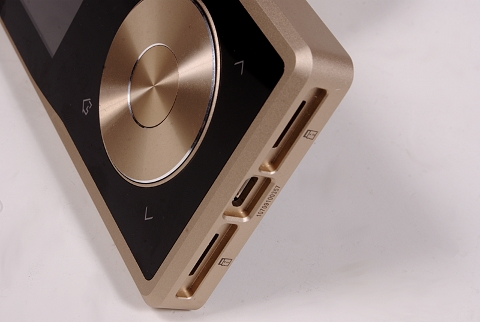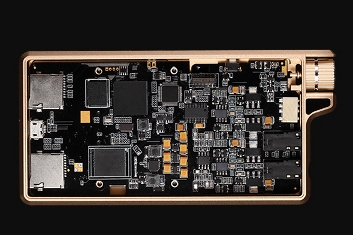about Audio, High Fidelity
& Home Entertainment technologies
pid: 607-2025/10/01 (v1.2)
Privacy Policy

QP1R is a well-made device, with a moderate size chassis (having dimensions 134x65x15mm) constructed from a one-piece aluminum block. It is available in two colors, gold (the one shown in the photos) and gray metal. Worth mentioning details include the top-positioned, stepped volume control which offers a sense of high quality during its use and the very good display which -despite its relatively small size- is easy to read. The metal casing is completed with two surfaces (which form the front and the back sides). These are built from Gorilla Glass which is impact and abrasion resistant, to ensure that the device will remain free of visible wear for a long time. The front surface plays the role of the user interface as it is touch-sensitive and offers access to some basic functions while the user also has at his disposal a jog dial and a centrally mounted push-button to access both the menus and the music library.
QP1R is a well-made device with a one-piece aluminum chassis. Front and back panels are from wear and abrasion resistant Gorilla Glass.
Connectivity offered by the QP1R include a headphone output through mini TRS 3.5mm jack, as well as two additional outputs through a combo TRS/Toslink 3.5mm jack. Through this, the user can access both analog (line out) and digital (Toslink) signals, the second one through a special adapter which is supplied. The line output level can optionally be controlled. These two outputs are the way one can connect QP1R to a home system and use it as a conventional, high-resolution digital source.
The menu gives access to a range of options which allow the player to be customized as the user requires. Among these are a library browsing mode, a three-position sensitivity selector to match the headphones connected, and the equalizer menu, which offers the option to save two different presets. Navigating through the music library is quite easy and fairly standard. The user can simply access it as a list, display the contents organized in folders or make searches based on the metadata of the files themselves (title, artist, album and type) and can, additionally, create its own playlists or place some tracks to a pre-configured list called "Favorites". Random and repeat playback modes are also available. If along with the audio files, cover images are included, they are displayed on the screen, which also offers useful information related to the type of file, sample rate, times, etc. Despite the data volume displayed simultaneously and the quite small characters used, screen resolution and brightness proved to be more than enough and there should be no difficulty to read them quite easily.
Handling the media player and browsing through the menu and the music library is quite easy, using a combination of four touch buttons, a jog dial and a central "Ok" button.
Volume control adds, without a doubt, some character to the device and is very pleasant to the touch. Right next to it, are the headphones output and the second, combo 3.5mm TRS analog/Toslink digital, output.
The player features 32GB of internal memory but the user has the option to expand the total capacity of the device with two microSD memory cards with a maximum capacity of 128GB each. This feature raises the overall capacity to 288GB. Loading the music files to the device is an easy task. QP1R can be connected to the host computer through USB and be identified as a storage medium. The file transfer is done using standard tools offered by each operating system (like drag/drop in the Windows file manager) or through the file management tools of the host's media player.
Power to QP1R is supplied from a rechargeable battery with a capacity of 3300mAh, which gives a playback duration of about 8 to 10 hours, according to Questlye. Recharging can be done either through a USB port (it will take almost eight hours) or through a standard USB charger, capable of supplying 2A current, in which case it will take four hours. Curiously, Questyle does not include such a device with the player and the user needs to separately buy one.
The USB port for transferring files (in the middle) and the two slots for the microSD cards that offer a memory expansion up to 2x128GB, for a total of 288GB.
Meticulous workmanship and attention to detail. The QP1R features a DAC chip from Cirrus (around the board center) and an analog stage with both operational amplifiers and discrete semiconductors (right, photo source: Questyle).
Questyle has managed to fit QP1R's aluminum chassis with everything needed for a high-quality digital device. Apart from the onboard memory and the display and playback processing electronics, the circuit includes a digital audio section based on the CS4398 D/A conversion chip from Cirrus (capable to process both PCM and DSD streams) and a double clock with separate time base for 44.1kHz and 48kHz-based signals, an architecture which Questyle -and other manufacturers- usually apply to digital audio products for home use.
Output from CS4398 is a voltage signal (so, there is no need for an I/V converter) and Questyle uses operational amplifiers to implement a circuit which precedes the power stage, in a topology based on what the company calls the Current Mode Amplification. CMA appears to be used on all Questyle headphone amplifiers and, according to the published information, is a three-stage circuit, of which the middle stage provides current amplification while the other two are conversion stages, a voltage to current (the first) and a current to voltage (the last). Based on Questyle's presentation of the CMA topology, current amplification offers considerable advantages, including much better speed and consequently very low intermodulation distortion, while in the general literature one can find that current amplifiers are considered very good in their noise and crosstalk performance. The headphone amp's output stage is implemented by complementary pairs of discrete bipolar transistors BCP56/BCP53 (NPN/PNP) and has a very low output impedance (0.15 Ohms) which allows the device to drive headphones of low or high nominal impedance without any difficulty. According to the specs published, with its sensitivity set to "High" (which is suitable for headphones with high nominal impedance), QP1R delivers 12mW/300ohms, while, in the "Low" setting (for headphones with low nominal impedance), delivers 8.8mW/32 Ohm.
Previous | Next | More Reviews






